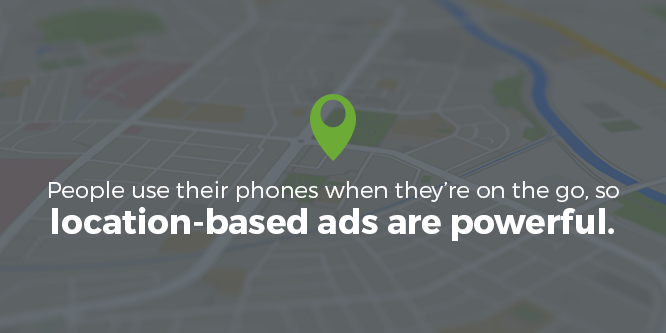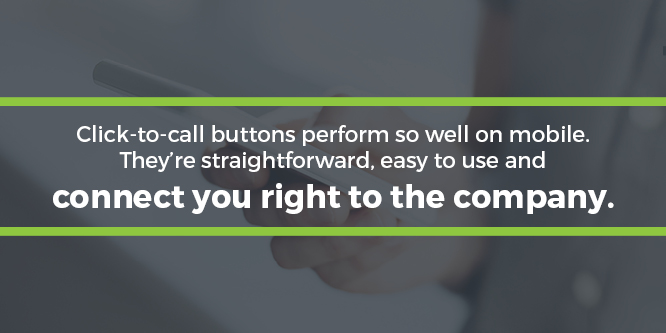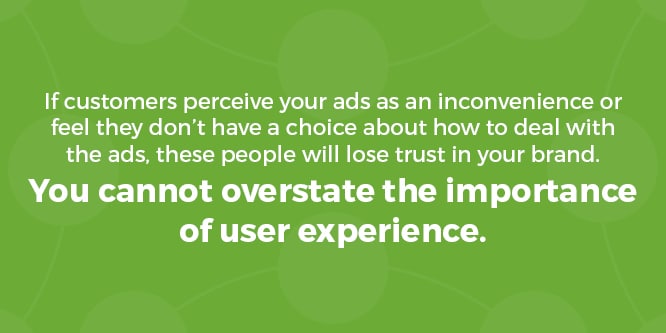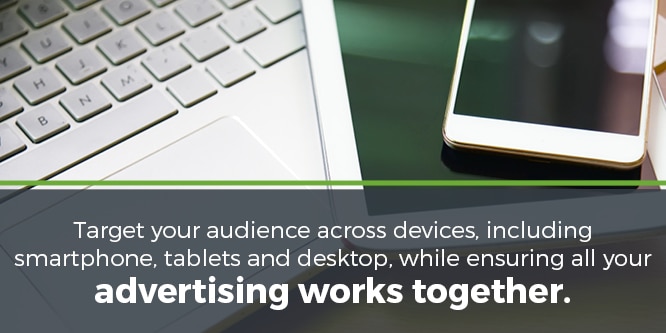Did you know that there are more than 3.5 billion unique users of mobile internet, and the average user spends 69 percent of their media time on their smartphones? That adds up to a lot of opportunities to reach potential customers on their mobile devices. Getting results from mobile advertising requires reaching the right person in the right place at the right time.

Data enables marketers to do that. It helps them understand who would be interested in what they’re promoting and figure out the best way to reach them. Marketers just need to be able to collect, organize and analyze that data even when it comes from multiple devices for a single user, which is where data management platforms and cross-device technology comes into play.
Just because you’re analyzing data, though, doesn’t mean your advertising will be robotic and impersonal. In fact, the mobile marketing data you collect helps you to learn more about your customers and target audience down to the individual level and allows you to better connect with them. Read on for top tips on how to use mobile advertising and get the most out of it with data and personalized connection.
Know Your Audience
As with all advertising, knowing your audience is crucial. Your audience is ultimately who your marketing materials are for. Understanding these people better will improve virtually all aspects of your campaigns.
Before you put any money into mobile marketing, you need to identify your target audience — the segment of the population you want your advertising to reach. Your target segment should be the people you think are most likely to perform the action you want them to take, whether that’s buying a product, installing an app or signing up for an email list.
You can look at demographics such as location, occupation, and age as well as characteristics like interests and purchase history. Don’t be afraid to get specific. A Nielsen study found that advertising aimed at narrower audience performed between 10 and 20 percentage points better on mobile than on desktop, perhaps due to the highly personal nature of smartphones.
Then, design your mobile advertising to appeal to those people and to show up only to those people on the platforms they use. Some advertisements might perform better on Facebook than on LinkedIn or vice versa. Some audiences might prefer a text message over an in-app ad.
Remember that you won’t define your target audience perfectly on the first try, and even if you did, it would likely change over time. Keep close tabs on your campaigns’ performances and tweak the definition of your targets accordingly.
Consider Mobile Habits
One of the biggest mistakes marketers make when going mobile is not designing their advertisements for the way people use mobile devices. People employ their smartphones differently than their desktops, so creating campaigns with those habits in mind will make your marketing much more effective. Responsive ads are great, but if mobile is your focus, you should embrace mobile-first ads.

Here are three mobile habits you should keep in mind:
- People use their phones when they’re on the go, so location-based ads are powerful.
- People jump on their phones when they have a spare second or need information quickly, so give your ads immediate appeal.
- People often aren’t on their phones for long periods, so make interacting with your ads quick and easy.
Those habits apply to the broader population, but you can also drill down and incorporate specific data on your customers’ habits into your strategy. For example, find out if your customers peruse search engines, apps or web browsers the most on their phones and place your ads there. You can even individualize your ads to specific customers. If your data shows you whether people use your company’s app or your mobile website more, for instance, you’ll know which one to place more ads on.
Use Location Data to Make the Biggest Impact
One of the most powerful demographic characteristics to consider is location. Targeting users based on where they are, often called geotargeting, makes your ads more relevant and personal to your audience and creates higher engagement levels and return on investment.
Google searches including the phrase “near me” increased 130 percent year-over-year between 2014 and 2015, and 88 percent of those searches occurred on mobile. People use their phones to find services and stores while they’re out. If you can reach those customers on their phones at the right time, you can send them in the direction of your shop.
One way to do this is geo-aware targeting, which pushes ads to your target audience when they’re in a particular location. For example, passersby might get an ad for your restaurant when they’re near it. You could also serve up an ad for sunglasses to people at the beach. Or show your audience ads for your store when they’re near a competitor’s store. Ads that tell users how far they are from your nearest location are useful on mobile, especially if the ads allow people to click for directions.
You can add more context and make your ads more effective by incorporating other types of data as well. For instance, you can advertise seasonal services or products such as beach chairs in the summer and snow blowers in the winter.
You can incorporate weather data and display ads for jackets on a cold day or sunscreen on a sunny day. You can even push ads to users in a specific location during a specific timeframe. For example, you could send sports-themed ads to users who are at a football stadium during a game.
Track click-through rates to see which ads resonate and which do not. You can also look at time spent on a landing page to see if you are sending your audience to the right place.
Mobile Advertising Is About Immediacy
Mobile advertising is all about reaching the right user in the right place at the right time. When you find that perfect “mobile moment,” you’ll create a sense of immediacy and are more likely to inspire engagement.
You can target ads based on time. For example, you’ll probably do better advertising a coffee shop in the morning as people are getting ready for work than in the evening. You can also combine location data, as mentioned earlier, with the perfect timing to reach customers when they’re in or near your store with a coupon or other special offer.
Including calls to actions, or CTAs, designed for mobile is another crucial mobile advertising tip. A well-designed one can help create a sense of urgency and inspire your audience to engage. To create an effective mobile CTA, make sure it gets right to the point, it’s clearly visible, and it’s easy to use. Add a phone number, too.
The fewer buttons users have to click, the better. Marketers sometimes say with every extra click on mobile, you lose half of your audience. That’s why click-to-call buttons perform so well on mobile. They’re straightforward, easy to use and connect you right to the company.

Dynamic banner ads including buttons that take users back to product pages they previously viewed are useful for these reasons as well. You might even display these banner ads around the same time of day the user saw the product page before.
Allow and Encourage Social Sharing
A lot of social media sites are used primarily on mobile devices. Twitter, Instagram, Facebook, and Snapchat are all highly mobile. Instagram is decidedly mobile-first, so most users access the service only on mobile devices. Even Facebook, which has a strong desktop site as well as a mobile app, says that over half of its users visit Facebook only on mobile devices.
Encouraging social sharing should be a central part of any mobile marketing strategy. Design your ads to be highly shareable:
- Make ads look good on social by including a large, high-quality image
- Create ads users will find helpful, interesting or funny, so your audience will want to share the ads
- Include an easy-to-see button that lets the user share directly to their social account while still giving people an opportunity to edit the post and add a personal message to their followers
Do the same when a customer purchases a product or downloads an app. Make it easy for the person to share their purchase on social and recommend it to their friends. The easier it is to share, the more people will do it. Also, encourage sharing by giving customers a referral code and an opportunity to get an exclusive deal if they share. Social enables your content to reach a broader audience. People also trust recommendations from their friends.
Put Users in Control
People are used to being in control of their mobile experiences. If your ads get in the way of that, users will likely get annoyed and may form an unfavorable opinion of your brand. Working with your audience, giving them options and trying to keep them happy will provide better results.
Various laws and company policies require a certain amount of honesty, transparency, and respect for privacy preferences. Adhering to these ideas also creates trust between you and your audience. It’s vital all advertisers make it easy for users to opt-in and out of data collection and advertising. Give users these options while explaining the value participating could have for these customers.
To avoid annoying your customers, you’ll also need to make sure your ad placement is appropriate. You should avoid ads that pop up in the middle of time-sensitive tasks such as online games. Also, don’t create ads that take up a viewer’s entire screen, and make sure it’s obvious how people can close the ad. If customers perceive your ads as an inconvenience or feel they don’t have a choice about how to deal with the ads, these people will lose trust in your brand. You cannot overstate the importance of user experience.

Make Data-Driven Changes
You should always monitor data on your advertisements’ performance and use that information to adjust your strategies as you go. Make sure you mark data as desktop or mobile, so you have a better idea of where your customers are coming from and what’s bringing them to you.
It’s also helpful to segment your audience and look at data for smaller groups or even individuals. Doing this will make it easier to get actionable insights from the information. You can use a data management platform to collect, organize and analyze data.
The rise of big data means there’s a ton of useful information available. You can collect and analyze data on things such as:
- Engagement: One of the most helpful types of data is engagement, which includes click-through-rates, time spent on landing pages and conversion rates. This data can help you determine which types of ads work best and gain more information on how your audience uses their mobile devices.
- Return on Investment: You should also measure how much you spend to get each click-through or conversion vs. how much revenue you make from each one. If you combine this data about which ads were most effective and which population segments responded best, you can increase the efficiency of your campaigns and improve your bottom line.
Mobile data management and collection is an ongoing process. You can also implement A/B testing, which involves testing two variations of an ad to see which works better, to optimize your mobile marketing materials. With all this data in mind, you can tweak your strategy to increase engagement and, ultimately, the success of your campaigns.
Less Is More
Another key tip for how to use mobile marketing is remembering that less is more. It’s important to remember you’re working with a smaller screen, so including too much information or too many images can make your ad look jumbled and hard to read. Instead opt for one large picture, just a few words of text and a simple call-to-action button, which will lead to a much better experience for your customers.
Not only will this make your ad look professional, but it will also encourage engagement. Because mobile users often just quickly glance at their phones in search of specific information, this audience won’t take the time to read a lengthy ad. You need something punchy and to-the-point to get their attention. Remember, mobile users have plenty of options for how to get their information, so you need to say what you want to say quickly.
Simpler ads will also load faster, which is crucial because if an ad is not loading, users will just click away. Smaller, less-obtrusive ads will also leave viewers with a more positive impression because such ads detract less from their overall mobile experience.
Integrate Your Efforts on Other Media and Platforms
Establishing a successful mobile marketing strategy is crucial, but so is integrating it into your overall advertising strategy. Target your audience across devices, including smartphones, tablets, and desktop, while ensuring all your advertising works together. You want to create a consistent message and implement plans that complement each other.

While mobile advertising is powerful, some users might convert better on desktop or through a combination of both mobile and web. You can even deliver sequential messaging by applying a customer profile across devices and keeping track of where a customer is in the sales funnel. Lotame’s cross-device technology can help you track this data so you can create more fluid, comprehensive and personal campaigns.
Mobile advertising is on the rise, but the importance of personal connection isn’t going away, either. Follow these mobile advertising and marketing tips, and you’ll be on your way to creating a mobile marketing strategy driven by the needs of your target audience as understood through data.
Learn more about how Lotame’s next-generation data platform, Spherical, can create smarter, faster and easier ways for marketers and media companies to drive growth and derive value from customer data. Contact us or request a demo today.